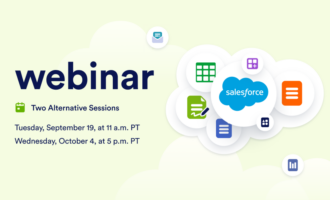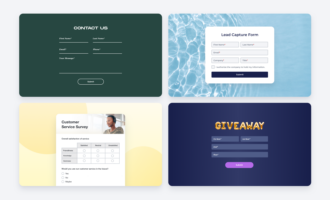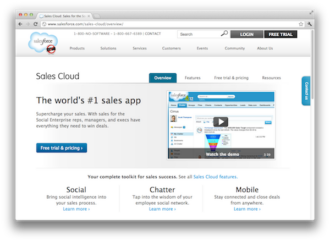A sound process for tracking and nurturing leads and opportunities is crucial for driving sales growth. Luckily, Salesforce can help by providing businesses with the tools they need to effectively manage their sales pipeline from lead to closed deal.
Without clarity on the distinction between a lead vs opportunity, you risk mismanaging your pipeline and missing out on new deals. Read on to learn about the differences between a lead and opportunity in Salesforce, as well as how to leverage both to their full potential.
Lead vs opportunity in Salesforce: What’s the difference?
When differentiating between a lead vs opportunity in Salesforce, consider where a prospect is in their buying journey. Leads are people who’ve shown an interest in your brand but need more time and information before deciding to buy from you. Meanwhile, an opportunity is a prospect who was once a lead but is now further down the funnel and more likely to act on a purchase.
What’s a lead in Salesforce?
A lead represents a potential customer who’s expressed interest in your product or service.
This could be someone who signed up for your newsletter on your website, attended a webinar, or downloaded an e-book. At this stage, they may have provided some basic contact information, but you still don’t have a full picture of who they are.
In Salesforce, a lead record contains details like the lead’s name, company, email, and phone number. You can also add custom lead fields like industry or lead source (i.e., how they discovered your business).
What’s an opportunity in Salesforce?
An opportunity represents a qualified lead your sales team has engaged with and developed into an active sales deal. In other words, these are leads who your business has vetted, whose needs have been identified, and whose budgets have been confirmed — and now, your sales reps are trying to close the deal.
Unlike lead records, opportunity records in Salesforce contain more detailed information, such as the account name, opportunity name, stage, amount, and close date.
How do you turn Salesforce leads into opportunities?
Now that you know the difference between a lead vs opportunity in Salesforce, it’s important to understand how to convert a lead to an opportunity within the platform.
Once you’ve contacted the lead, qualified them, nurtured them, and converted them into a new active opportunity, follow these steps:
- Click on the App Launcher, and open the Sales app.
- Click on the Leads tab.
- Select the relevant lead you want to convert to an opportunity.
- Under the dropdown menu in the top right corner, select Convert.
- Fill out the relevant opportunity fields in the popup box.
- Click Convert.
As soon as you’ve completed these steps, you’ll see a link to the newly generated opportunity.
How can Jotform help with lead generation?
While Salesforce is a powerful tool for tracking your sales pipeline, it doesn’t help you actually find and convert new leads.
Enter Jotform. A popular form builder, Jotform makes it easy to create customized surveys, popups, and contact forms that successfully entice prospects to share their information and start the customer journey.
Here are some tips for using Jotform to level up your lead generation:
- Leverage one of our 200-plus lead generation templates. Rather than reinvent the wheel, just customize one of our premade lead generation forms with the drag-and-drop builder, and embed it on your website. Not only is all the data you collect stored securely in your Jotform account, but it also syncs directly with Salesforce, eliminating the need for manual data entry.
- Create a lead generation quiz. Build a personality quiz, product finder, or needs assessment using Jotform’s quiz maker. By offering something interactive, you can engage site visitors, making it more likely that they’ll share their information with you.
- Add an email opt-in form to your website. Embed an email popup with an incentive, like a discount or exclusive gated content (such as an e-book or white paper), that they’ll receive in exchange for providing their email address.
How can you make the sales process easier and more effective?
Carefully managing your sales process throughout every stage — from an initial lead to a promising opportunity to a closed deal — is critical for any growing business. The last thing any brand wants is to lose out on potential revenue because they didn’t deliver the information or support that a lead needed to convert.
Jotform for Salesforce makes it easy to capture more inbound leads to fuel your sales pipeline. With just a few clicks, you can build custom lead generation forms, embed them on your site, and seamlessly sync new contacts to Salesforce.Check out our lead generation templates today.
Photo by Pavel Danilyuk































































Send Comment:
1 Comments:
311 days ago
This blog post provides a clear and informative distinction between leads and opportunities in Salesforce. Understanding this difference is essential for any business aiming to optimize its sales pipeline effectively. The breakdown of what constitutes a lead and how it transforms into an opportunity is particularly helpful.
The step-by-step guide on converting a lead to an opportunity within Salesforce is straightforward and beneficial for anyone using the platform. The mention of Jotform as a tool to enhance lead generation complements the Salesforce process nicely. The suggestions on utilizing Jotform's lead generation templates and creating interactive quizzes are practical tips for maximizing lead collection.
Overall, this post is well-structured and provides valuable insights for businesses seeking to streamline their sales processes and make the most out of Salesforce and Jotform. Great job in delivering this informative and insightful piece!